-
History & Society
- Education in Pre-war Hong Kong
- History of Taikoo Sugar Refinery
- Hong Kong Products Exhibition
- Local Festivals Around the Year
- Post-war Industries
- Pre-war Industry
- The Hong Kong Jockey Club Archives
- Tin Hau Festival
- Memories We Share: Hong Kong in the 1960s and 1970s
- History in Miniature: The 150th Anniversary of Stamp Issuance in Hong Kong
- A Partnership with the People: KAAA and Post-war Agricultural Hong Kong
- The Oral Legacies (I) - Intangible Cultural Heritage of Hong Kong
- Hong Kong Currency
- Hong Kong, Benevolent City: Tung Wah and the Growth of Chinese Communities
- The Oral Legacies Series II: the Representative List of the Intangible Cultural Heritage of Hong Kong
- Braving the Storm: Hong Kong under Japanese Occupation
- A Century of Fashion: Hong Kong Cheongsam Story
Geography & EnvironmentArt & Culture- Calendar Posters of Kwan Wai-nung
- Festival of Hong Kong
- Ho Sau: Poetic Photography of Daily Life
- Hong Kong Cemetery
- Sketches by Kong Kai-ming
- The Culture of Bamboo Scaffolding
- The Legend of Silk and Wood: A Hong Kong Qin Story
- Journeys of Leung Ping Kwan
- From Soya Bean Milk To Pu'er Tea
- Applauding Hong Kong Pop Legend: Roman Tam
- 他 FASHION 傳奇 EDDIE LAU 她 IMAGE 百變 劉培基
- A Eulogy of Hong Kong Landscape in Painting: The Art of Huang Bore
- Imprint of the Heart: Artistic Journey of Huang Xinbo
- Porcelain and Painting
- A Voice for the Ages, a Master of his Art – A Tribute to Lam Kar Sing
- Memories of Renowned Lyricist: Richard Lam Chun Keung's Manuscripts
- Seal Carving in Lingnan
- Literary Giant - Jin Yong and Louis Cha
Communication & Media- Hong Kong Historical Postcards
- Shaw Brothers’ Movies
- Transcending Space and Time – Early Cinematic Experience of Hong Kong
- Remembrance of the Avant-Garde: Archival Camera Collection
- Down Memory Lane: Movie Theatres of the Olden Days
- 90 Years of Public Service Broadcasting in Hong Kong
- Multifarious Arrays of Weaponry in Hong Kong Cinema
-
History & SocietyGeography & EnvironmentArt & Culture
-
View Oral History RecordsFeatured StoriesAbout Hong Kong Voices
-
Hong Kong Memory
- Collection
- All Items
- The Dawning of Hong Kong Cheongsam: The Late Qing Period to the 1920s
Recently VisitedThe Dawning of Hong Kong Cheongsam: The Late Qing Period to the 1920s
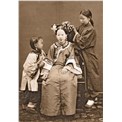
- Manchurian lady has her hair dressed
A Manchurian lady has her hair dressed. Manchu women were meticulous about their hair. They liked to roll it into a high bun or wear bun extensions, and then adorn the hairdo with flowers. They traditionally wore a tight-fitting dress with narrow sleeves, but in the late Qing period the trend towards a looser cut and wider sleeves developed as a result of the cultural intermingling between the Manchu and the Han. Taken in Beijing, circa 1871/1872.
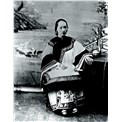
- Typical outfits worn by noble Han women in the Qing period
This photograph shows the typical outfits worn by noble Han women. The loose cut completely conceals the women's figure from view.
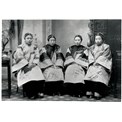
- Huge jacket-and-trousers combination worn by women throughout the Qing period
"Almost throughout the Qing Dynasty (1644-1911), the classical ensemble was a jacket-and-trousers combination. In size and length the jacket corresponded to the modern swagger coat. The collar was very low; huge sleeves and trousers gave a feeling of statuesque repose." – Eileen Chang, Chinese Life and Fashions, 1943.
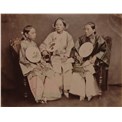
- Small bound feet and loose clothing
Small bound feet provided a stark contrast to the loose clothing, creating an image of imbalance between a heavy top and a feeble base. Taken in Hong Kong, late 19th century.
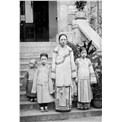
- Slim and slender fit clothing in the late Qing
The clothes of the early 20th century adopted a slim and slender fit. The bindings became narrower in response to the body and sleeves having become tighter.
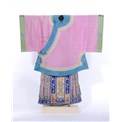
- Upper garment and pleated skirt worn by Han-Chinese women (1)
In the Qing period, the typical Han-Chinese women's garment usually adopted a loose cut to disguise the shape of the body. As for shoes, they were extremely dainty. Loose-cut upper garments have broad sleeves and decorative borders. The collar, however, is narrow and small. Pleated skirts are ornate and brightly coloured – just like other costumes during Qing times.
Pink upper garment with jacquard-woven floral motif and pleated skirt adorned with 'Eighteen Trimmings'
Late Qing period (mid-19th to early 20th century)
Hong Kong Museum of History collection
The upper garment has a loose-cut and wide sleeves. The ornate pleated skirt features decorative borders on the front and back panels that are adorned with 18 trimmings of various widths; it also has decorated strips hanging down on each side.
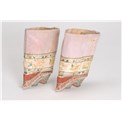
- Upper garment and pleated skirt worn by Han-Chinese women (2)
In the Qing period, the typical Han-Chinese women's garment usually adopted a loose cut to disguise the shape of the body. As for shoes, they were extremely dainty. Loose-cut upper garments have broad sleeves and decorative borders. The collar, however, is narrow and small. Pleated skirts are ornate and brightly coloured – just like other costumes during Qing times.
Shoes for bound feet
Late Qing period (mid-19th to early 20th century)
Hong Kong Museum of History collection
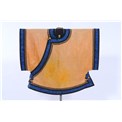
- Upper garment and pleated skirt worn by Han-Chinese women (3)
In the Qing period, the typical Han-Chinese women's garment usually adopted a loose cut to disguise the shape of the body. As for shoes, they were extremely dainty. Loose-cut upper garments have broad sleeves and decorative borders. The collar, however, is narrow and small. Pleated skirts are ornate and brightly coloured – just like other costumes during Qing times.
Children's yellow upper garment with jacquard-woven floral motif
Late Qing period (mid-19th to early 20th century)
Hong Kong Museum of History collection
This children's upper garment looks identical to the adult version. Several 1873 Hong Kong five-cent coins featuring the bust of Queen Victoria are uniquely presented as knot-shaped buttons.
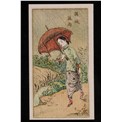
- Casual wear for women (1)
These are picture cards in the 1910s. The women depicted are dressed in popular styles of the time: slender and slim blouses, yuanbao collars, long skirts with few or no pleats, and long and slim trousers. The styles are simple and neat, presenting a stark contrast to the lavish decorations of Qing attire.
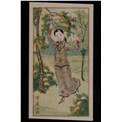
- Casual wear for women (2)
These are picture cards in the 1910s. The women depicted are dressed in popular styles of the time: slender and slim blouses, yuanbao collars, long skirts with few or no pleats, and long and slim trousers. The styles are simple and neat, presenting a stark contrast to the lavish decorations of Qing attire.
Copyright © 2012 Hong Kong Memory. All rights reserved.
| Set Name |





